Two weeks ago, the US Electoral College voted Joe Biden in as the next US President. The same day, the Church released a boilerplate statement congratulating Biden and Kamala Harris on their win, thanking Trump and Pence for their service, and asking members to pray for all of them. The statement was then linked in the Church’s public Newsroom group on Facebook. Commenters there proceeded to hold a heated debate that ran to 2200 comments before the Church’s public affairs people (I’m assuming) shut it down.
They didn’t delete the comments that were already up, though, so I thought it would be a fun project to read through them and look for patterns like most commonly raised issues. To be complete, I should note that some of the comments clearly had been deleted, as there were only 1882 remaining when I read them (starting about a week ago). However, given how many pretty unhinged comments still remain up, I doubt that it was the Church PA people deleting them. Rather, it seems more likely that people who had made comments went back and deleted them.
Here’s the data I noted for each of the comments:
- Name of the person making it. I noted this so I could see if it was a few people making a ton of comments, or a lot of people making a few.
- Lean of the comment (Biden – strong, Biden – weak, neutral, Trump – weak, or Trump – strong). Of course this is subjective but it’s pretty clear most of the time.
- Issues raised, which I sorted into a few dozen categories.
- Number of words.
- Comment being replied to, so I could see which comments drew the most replies.
- Number of reactions: Like, Love, Care, Haha, Wow, Sad, Angry
For the 103 people who made five or more comments, I also noted the following:
- Overall lean of their comments. This was straightforward, as people pretty much always showed a consistent lean from one comment to another.
- Total number of comments.
- Gender. Most people declare their gender in their profile.
- Age category (younger, middle aged, older). As most people don’t give their age on Facebook, I guessed based on graduation and marriage dates and apparent ages of children or grandchildren. I was thinking of the age groups as being approximately < 40 for younger, 40 – 64 for middle aged, and 65+ for older. Of the 103 people, I assigned age categories to 92 of them.
Comment Lean
As the graph below shows, Trump-leaning comments outnumbered Biden-leaning ones by nearly a 2:1 ratio. There were also nearly as many neutral comments as Biden-leaning ones.
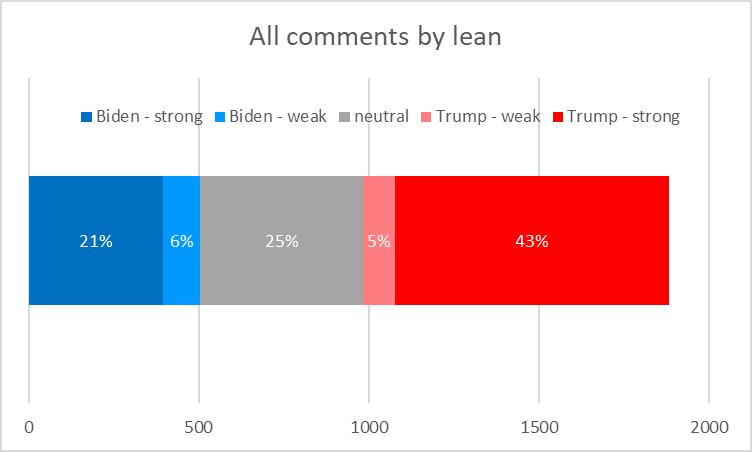
Comment Length
There were a total of 52,893 words in the 1882 comments, making for 28 words per comment. As the graph below shows, Trump-leaning comments were on average a little longer than Biden-leaning comments.
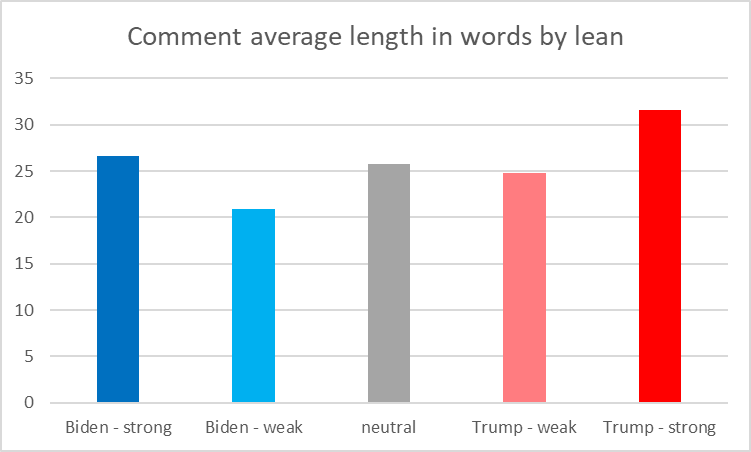
This difference was attributable to a small number of extremely long Trump-leaning comments, where commenters copy/pasted long explanations of how they thought the election process would play out, or long diatribes about Democrats’ many sins. As the chart below shows, when the comments are sorted into a few categories by length, the distributions for Biden and Trump supporters are not that different. It’s just the 16 200+ word comments in strong Trump-leaning comments (the darkest blue bit in the lower right part of the graph) that pull their average up.
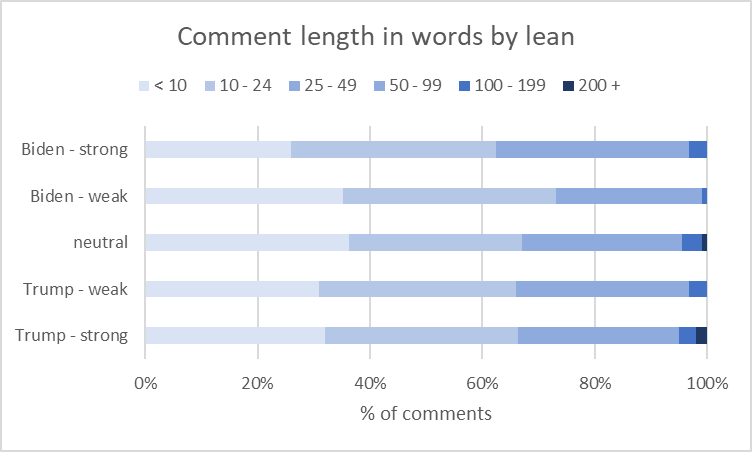
Comment reactions
The 1882 comments drew a total of 26,196 reactions, at least as of the last few days when I was checking. There are probably a few more now. Most (64%) were likes, followed by hahas (26%), loves (8%), and a small number of cares, wows, sads, and angries. The hahas were clearly functioning as a dislike, along the lines of “Haha! Your position is ridiculous.” Several of the commenters noted this, calling out other commenters for responding haha to their comments. As a side point, the fact that haha has come to be used this way in political discussions leads me to think that Facebook should really just give in and make a dislike reaction. People clearly want to use such a reaction, so they might as well make it rather than let haha be mixed up this way.
Where Trump-leaners dominated by numbers in comments, Biden-leaning dominated in the reactions. Strong Biden-leaning comments drew an average of 14.6 likes to only 1.5 hahas, while strong Trump-leaning comments actually drew more hahas (6.8) than likes (4.7). This graph shows the complete breakdown.
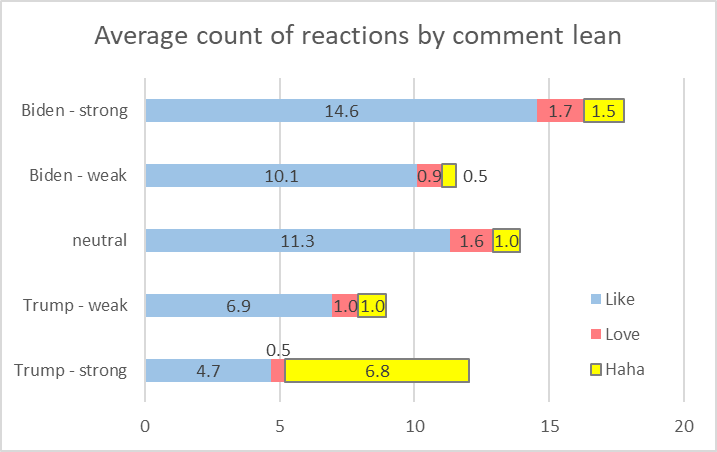
Issues raised by comments
The 1882 comments raised a total of 1974 issues, or 1.05 issues per comment. This is kind of surprising considering that a number of comments seemed to raise quite a few issues. However, there were also a lot that didn’t raise any at all, either because they were doing tangential things like tagging friends, or because they boiled down to name-calling and the like, which I didn’t count as an issue. There was a slight tendency for Trump-leaning comments to raise more issues on average (1.15) than Biden-leaning comments did (1.04). Neutral comments raised the fewest issues (0.88).
For this analysis, I lumped together all Biden supporting comments (strong and weak) and all Trump supporters (strong and weak) because the large number of different issues meant the data were kind of thin already. Only the top five issues were mentioned as often as 100 times, so breaking these mentions into three categories seemed safer than breaking them into all five.
The graph below shows the 18 issues that were raised at least 30 times, along with the percentage of comments that leaned Biden, leaned Trump, or were neutral that raised the particular issue. For example, the first three bars show that the question of whether the election is over or not was raised by 23% of comments that leaned Biden, 5% of neutral comments, and 18% of comments that leaned Trump.
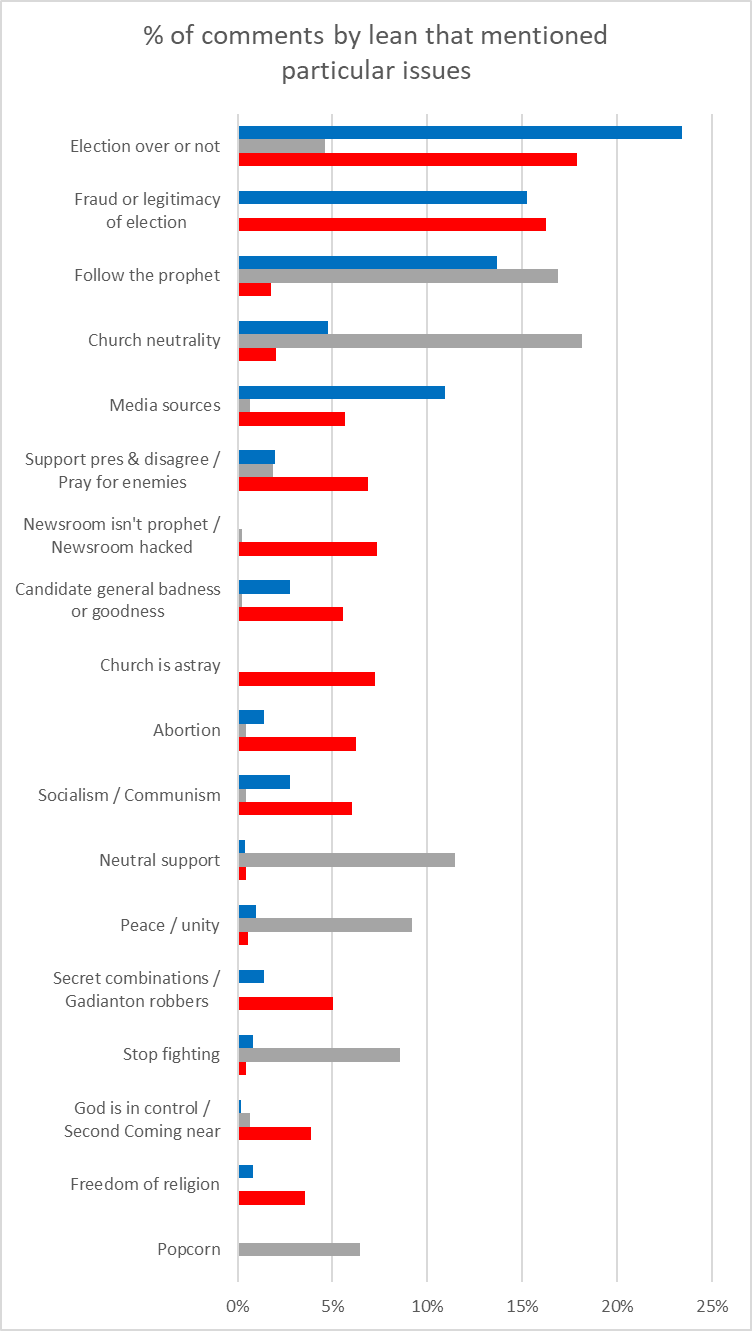
The patterns probably aren’t surprising. For example, Trump-leaning comments were more likely to bring up abortion and socialism, while Biden-leading comments were more likely to bring up the election being over and the importance of following the prophet. I do think it’s interesting to note that even just looking at the top issues, fringe ones like Biden/Harris being part of Gadianton-like secret combinations or the idea that the Church has gone astray show up. Also, in case it isn’t clear, the last issue–“popcorn”–just means people were commenting that they were entertained by the fights in the comments, without saying which side (if any) they sympathized with.
Top-level comments
I did a little separate analysis of the top-level comments, the ones that were responding directly to the original Newsroom group post. There were 413 top-level comments. Their breakdown by lean was different from the overall comment breakdown in that neutral comments were more common and Biden-leaning comments less common. This follows my general sense of the thread that top-level comments said, in one way or another, either “This is good; let’s support the Church and US leaders” or “This is bad; Trump was cheated and/or the election isn’t over yet,” and Biden-leaning comments generally appeared only in response to Trump-leaning comments.
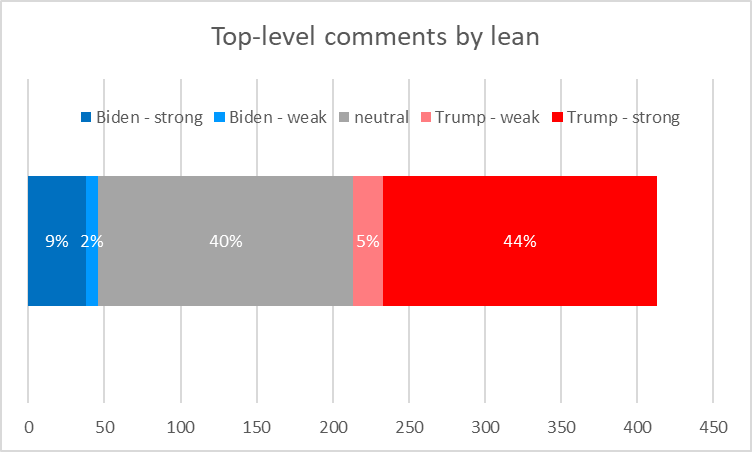
But why, you might ask, if there were so many neutral top-level comments, did it seem like the thread was dominated by fighting? The answer, of course, is that partisan top-level comments were more likely to draw replies than neutral ones were. The graph below shows the average number of response comments drawn as a function of the lean of the top-level comment. It also shows the count of reactions (likes, etc.).
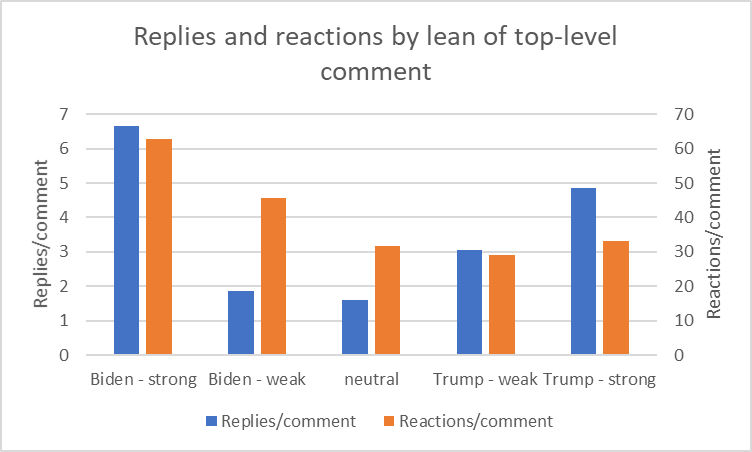
Top-level comments with a strong lean drew more response comments and also more reactions than did neutral top-level comments.
I also thought it would be interesting to see how many response comments and reactions top-level comments got depending on where they fell in the order of the 413 top-level comments. This graph shows the count of response comments and reactions for each of them. (Click the graph to see a bigger version.)
 What’s interesting here, I think, is to see that the number of response comments per top-level comment dropped off as the thread progressed. I didn’t note the time stamps of each comment, so I can’t check this, but I wonder if this just means that the arguments on the later top-level comments were just getting started when the comments were closed, while the arguments on the earlier top-level comments had largely run their course. You can clearly see the effect of closing the comments on the reactions, as the later top-level comments drew more reactions–sometimes dramatically more–than the earlier ones. I think this is clearly an effect of people coming back to the post after the comments were closed and seeing only the last set of comments, because that is all that loads by default, and reading through and putting reactions on them. By that point, the earlier comments were buried and required deliberate effort to load, so they drew far fewer reactions.
What’s interesting here, I think, is to see that the number of response comments per top-level comment dropped off as the thread progressed. I didn’t note the time stamps of each comment, so I can’t check this, but I wonder if this just means that the arguments on the later top-level comments were just getting started when the comments were closed, while the arguments on the earlier top-level comments had largely run their course. You can clearly see the effect of closing the comments on the reactions, as the later top-level comments drew more reactions–sometimes dramatically more–than the earlier ones. I think this is clearly an effect of people coming back to the post after the comments were closed and seeing only the last set of comments, because that is all that loads by default, and reading through and putting reactions on them. By that point, the earlier comments were buried and required deliberate effort to load, so they drew far fewer reactions.
Commenters
I looked in a little more detail at the 103 people who wrote five or more comments on the thread. For simplicity in aggregating their comments, I only assigned them a lean (Biden, neutral, or Trump) rather than also considering the partisan leaners strong or weak. The graph below shows the leaning breakdown.
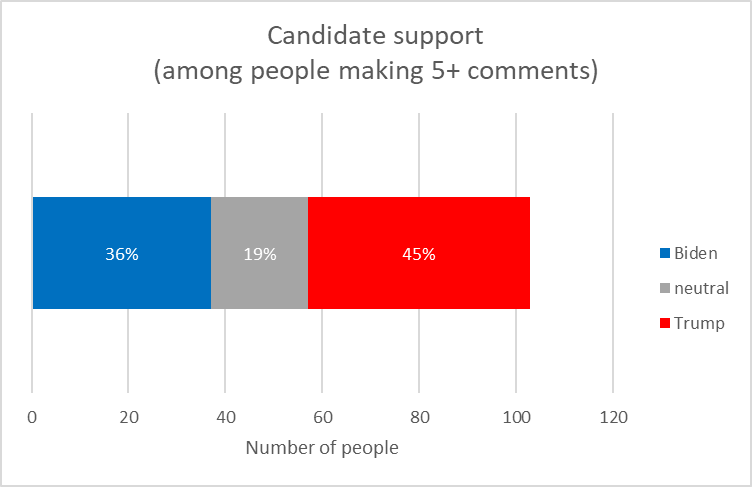
I also looked at the breakdown by gender, which this graph shows.
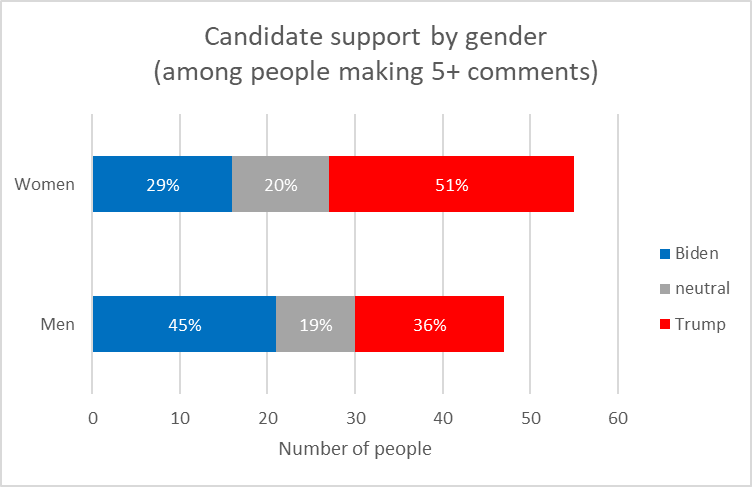
This is a small and non-random sample, so it likely doesn’t mean anything, but I think it’s interesting to see that the men on the thread leaned more toward Biden and the women more toward Trump, which is the opposite of the overall American pattern. Also, women outnumbered men on the thread, 55-47.
I also looked at the breakdown by age grouping, as shown in this graph.
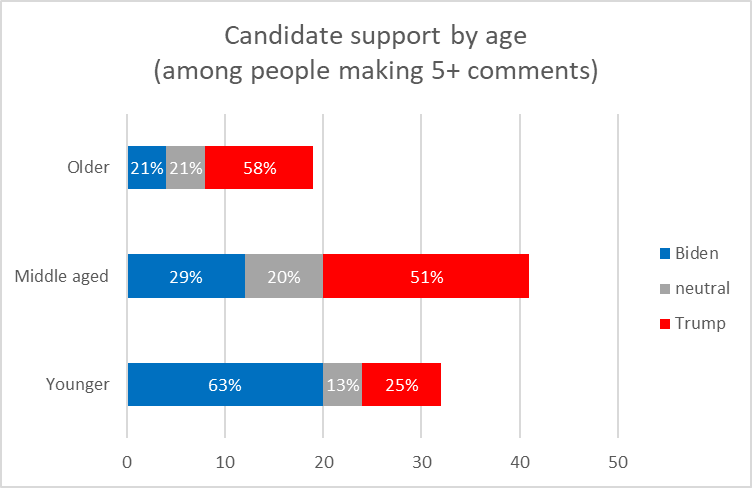
Here the pattern matches the overall American pattern, with younger people leaning to Biden and older people leaning to Trump.
Finally, looking at all people who made any number of comments, I looked at which way they leaned as a function of how many comments they had made on the thread. This graph shows the result.
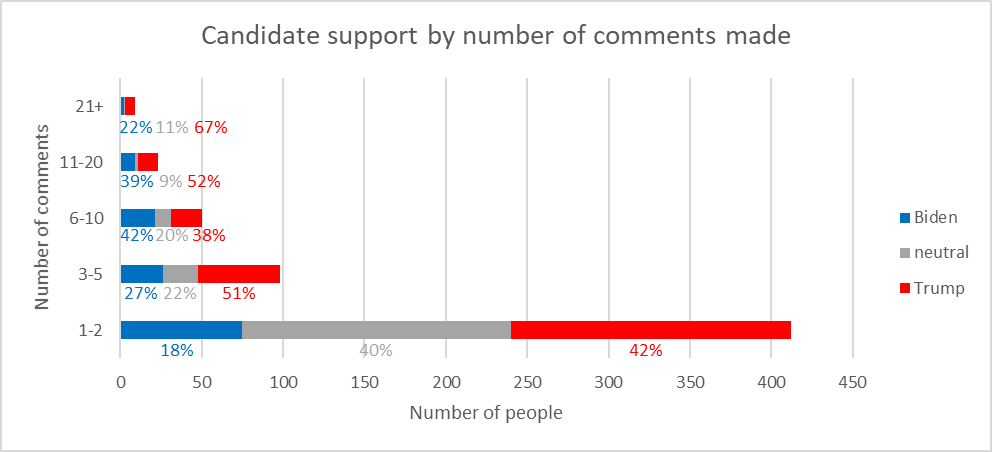
Trump-leaners were disproportionately represented among the people who made the most comments. The top three commenters, making 64, 40, and 38 comments, were all Trump-leaning, whereas the top Biden-leaning commenter made only 26.
Concluding thoughts
I had two last thoughts after reading all these comments. First, I think I kind of understand the people who are saying that the Church has gone astray. To them, it’s clear that supporting Republicans is one of the Church’s core values. They read Ezra Taft Benson quotes about the evils of the dole and lurking Communists running the Civil Rights movement in the 1960s, and they see past the transparent protests of neutrality. So now, when Americans elect someone who’s blatantly not a Republican to the highest office in the land, why, they wonder, is the Church straying from its core values and congratulating him rather than grasping at every possible conspiracy theory straw as a justification for ignoring that vote?
Their stance reminds me of an excellent post Cynthia L. wrote at BCC in the wake of the 2015 exclusion policy. She argued that the Church was going against everything it had taught her when it said that kids could be excluded from saving ordinances because of who their parents were. She pointed out that it was the Church that had taught her to stand up for what’s right even if it’s unpopular. I think the Trump disciples who are threatening to leave the Church over its refusal to condemn Biden are thinking along similar lines. Just to be clear, though, I think Cynthia L. is right and the Trump disciples are wrong because I do think that refusing to condemn kids for their parents’ choices does seem like more a core principle of the Church than supporting Republican candidates is.
My second thought is that I was at first surprised at people saying that the Newsroom had clearly been hacked, so they didn’t need to pay any attention to the Church’s statement, but that in retrospect it makes sense. Once you’ve decided that everything in the mainstream media (up to as far right as Fox News) is false, and that only conspiracy theorists and their fringe news outlets are daring to tell the outrageous truth, it makes total sense that it would be easy to conclude that the Church Newsroom site isn’t the most reliable source for information about the Church. After all, isn’t it official-looking and mundane, much like mainstream media often looks? Probably the best source for news about the Church is actually some obscure YouTube channel where conspiracy theorists mash up Ezra Taft Benson and Joseph Fielding Smith quotes with a liberal helping of doomsday prepping.
I would honestly not be the least bit sad if people who believe this nonsense made good on their threat to leave the Church. The Church has lost plenty of people on the political left over my lifetime, if not for political reasons directly, then often for politics-adjacent reasons like women’s rights. It would be nice if, just for once, the Church lost some people on the political right who decided that it just wasn’t conservative enough for them.
It would be even nicer if the Church could exert some influence on the far right and reign them in without losing them. And maybe the Church thinks it’s trying to–after all, it did counsel members to avoid sources of information that “promote anger, contention, fear, or baseless conspiracy theories.” Now it seems clear enough to you and me what that refers to, but 99.9 percent of folks who do rely on such sources of information are not going to recognize themselves from the Handbook statement. Ezra Taft Benson called out institutions he considered Communist-inspired with some specificity. Maybe the lesson the Church learned from that is that specificity is alienating and therefore a mistake, but the real lesson is that it works. We should try it again.
But regarding your analysis, many thanks for doing it. I read a fair number of those comments and even considered doing what you did. But I realized that it would take me much more than two weeks to dig out of that rabbit hole and I couldn’t justify the effort. And it wouldn’t have been as informative as this.
Thanks, Last Lemming!
“This difference was attributable to a small number of extremely long Trump-leaning comments, where commenters copy/pasted long explanations of how they thought the election process would play out, or long diatribes about Democrats’ many sins”
I had a facebook friend whose advocacy for Trump in 2015/16 was indefatigable; if I had not known he was a real person I would have thought he was a bot. He posted so much nonsense and so frequently that it was impossible to debunk it all, especially if you cared about being responsible with your own accuracy, a concern this person didn’t share, as he would simply reply to any objections with long and involved strings of new nonsense. It was hard to believe he could be so prolific and it didn’t take long to eventually realize that he couldn’t have even typed out his whole replies in the time before they appeared. Once I realized this, I discovered that a great proportion of his output was simply cut and pasted from other “sources”, including just copying other friends posts and replies, without any attribution.
Oh, wow, Bill. That totally makes sense. That’s exactly what it looked like at least a couple of people on this thread were doing.
Ziff, great analysis! I’m wondering what the age by gender split is of the 105+ commenters. As an explanation for the gender reversal (more women supporting Trump) I’d bet this sample had mostly young men supporting Biden and older women supporting Trump or, in other words, in Mormonism age may be a better predictor of party-affiliation than gender
Last Lemming, I might suggest that the church is doing exactly what you suggest it ought to, to the degree that such is possible. They are exerting influence on their members– but that you seem to imply that the church _can_ do this effectively and not lose those extremists.
I’m skeptical of this. It seems that conspiracism is destructive to individual agency, that believing in conspiracies tends to undermine an individual’s ability to perceive and act on truth effectively. Those that believe that the media can no longer be trusted and that conspiracies abound– these people are no longer listening to the church as it currently exists.
Instead, they only listen to what the church was/said at one time, long ago. As such, they _don’t want_ to be influenced away from extremism, because they don’t think of themselves as extreme, and they effectively choose to attack the church with old notions that may not even reflect doctrine promoted during the era, let alone more stable doctrine promoted in multiple eras.
Great post with really good data visualizations. It’s really interesting to see those comments aggregated in such a way.
I’m curious as to whether you exported the comments into a text document of some kind. It would also be interesting to compare the Flesch–Kincaid scores and do text sentiment analysis using the demographics you already identified.
.
I can’t imagine how much work this must have been, Ziff. Holy smokes.
Wow! Fascinating! Thank you!
Ditto to Th. and Violadiva’s comments. This is very interesting, Ziff!
Amazing work!
Thanks, everyone, for your comments. I’m glad you all enjoyed the post. Curious Data Scientist, that’s a great question. I should see if I can do the text complexity and sentiment analyses too.